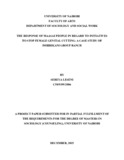| dc.description.abstract | Female genital mutilation / cutting / circumcision (FGM or FGC) are terms used to incorporate a
wide range of traditional practices that involve the partial or total removal of the external female
genitalia basically for traditional and cultural reasons mostly in African societies. Thus this study
addresses the perceptions of this practice and looks at different efforts by the Community Based
Organizations (CBO’s) and Government to eliminate this traditional practice among the Maasai
people of Kajiado County in the Republic of Kenya.
Thus the researcher set out to establish the community’s perception of FGC, what efforts have
been put in place by both the stakeholders and community in abolishing it and levels of
acceptance by the community in bringing it to an end.
This study was conducted among the residence of Imbirikani Group Ranch. In executing this
study, snow balling was applied. The application of this technique (snowball) aided the
researcher to not only be better placed with the selection of respondents but also in
differentiating between the circumcised and uncircumcised girls, as it has been discussed in
chapter three. It thus made the data collection exercise easier and time saving. FGC is organized
by the village elders bringing together girls of the same age group to be circumcised. This is
done majorly to save on costs and also due to the convenience of the period it is engaged.
The research findings revealed that 80% of the girls are not in support of the practice being a
must rite of passage. Their perception was found to be in agreement with that of the government
and some of the area residence. They were also secure to be introduced to the alternative rite of
passage which its teachings would keep to the norms and values of the Maa people without
causing any harm to their bodies. The findings also indicated that perceptions held by those who
are in favor of the practice are based on a number of motivating factors, tradition topping the list.
The open campaign efforts that are being employed by AMREF and the CBO’s in the ranch,
with the support of the government to eliminate FGC in Maasai land is slowly being welcomed
by the residence. Thus as a result of these efforts, there has been a gradual change in the
community; however this does not yet mean that the practice has been eliminated. But through
the research findings and recommendations, the practice will slowly be faced off. However
through “Cultural Lag Theory,” explains the fact that all parts of culture do not change at the
same pace. His argument was that the rapid change in material conditions had resulted in
numerous examples of what he termed “cultural lag.” He used this term to describe what happens
when related parts of a culture react to some change to strikingly different degrees, or with
different speed.
Hence it aided in understanding why FGC still persists in the Maasai community in spite of the
introduction of formal education. The research therefore recommends that the stakeholders
through their campaigns of using role models should engage them further to act as mentors and
reach out to the young girls. This will hence enable the young girls not to easily be swayed by
peer pressure and give into the knife. | en_US |

